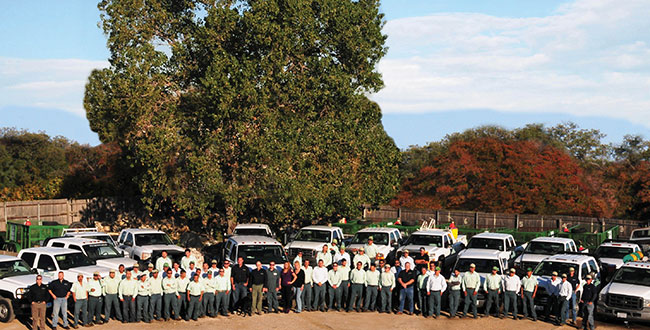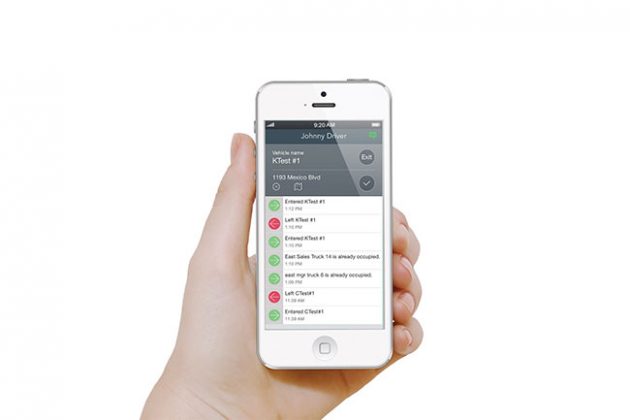
News
Landscaping
GPS tracking aids landscapers during COVID-19 pandemic
Technology allows both social distancing and fleet tracking
December 14, 2020 By Story by Advanced Tracking Technologies
 GPS tracking technology allows landscapers with such large fleets and personnel as this to keep tabs on their vehicles and stay safely distanced.
GPS tracking technology allows landscapers with such large fleets and personnel as this to keep tabs on their vehicles and stay safely distanced. In the midst of the COVID-19 crisis, landscaper business owners and fleet managers still need to manage their fleets, but may not want to go to the office daily and risk possible exposure to themselves or others.
Fortunately, by using new technology offerings like a real-time GPS vehicle tracking system via a smartphone, tablet or PC – remotely, in addition to email, Zoom meetings, etc. – they can socially distance as well as dynamically manage their fleets and work crews throughout the day without missing a beat.
In fact, compared to traditional techniques like meeting face-to-face and shuffling paperwork, the advanced technology now available actually improves control and allows immediate response and adjustment to the inevitable emergencies and changing demands that occur throughout the day.
“With an advanced, real-time GPS vehicle tracking system, essentially all employees can socially distance,” says Ben VanAvery, director of sales and marketing at Advanced Tracking Technologies (ATTI), a Houston-based designer and manufacturer of GPS tracking products. “To avoid potential viral transmission from other employees and vehicles, they can leave from their homes in their typical company vehicle and go directly to the job site without returning to the office, except to retrieve any needed supplies.”
Such a GPS tracking system can facilitate social distancing and virtually eliminate the need for routine personal interaction, while ensuring that drivers and work crews stay on task.
When logistics during the pandemic require it, emergencies occur, or work must be handled by the nearest qualified, available technician, such a system can be advantageous. With real time GPS vehicle tracking, landscape company managers can see which technicians they have across the area, including who is nearest and who is experienced and properly qualified for the job. And by accessing real-time traffic data in the software, they can identify who is easiest to send to that location as well.
As an example, one particular GPS vehicle tracking device transmits 10-second updates, showing precisely where vehicles are the moment the fleet manager or dispatcher needs to know.
Compared with some other GPS tracking devices that may only update every few minutes, the system provides real-time location updates as well as speed and idle time alerts if something is amiss. This data is transmitted via satellite and cellular networks to a smartphone or PC on a 24/7 basis. The system has access to nation-wide speed limits in its database.
Dispatches can be made throughout the day and sent directly to the driver’s phone to tell the work crew the next job site address. Once a job is completed, it is recorded in the system, so the dispatcher, owner or fleet manager can stay apprised. In that way, it can serve as a remote time sheet.
Greg Hamman, owner of Prime Landscape Services in Dallas-Fort Worth, has already put such a capability to good use. Currently, the landscape contractor has about 20 lawn maintenance crews serving north Texas, and a total of about 55 service vehicles company-wide.
According to Hamman, he can display the real-time location of his entire vehicle fleet on a map via a phone app, and zoom in on any specific truck. At a glance, he can see if a truck is moving (displays green) or stopped (displays red). If he touches a truck icon, the app will display where the truck has been, where it stopped, and how long it has idled. All this helps with customer support, and with on-the-fly coordination.
“I can pull up my smartphone and see exactly where my trucks are in route, if they’re picking up material, or stuck in traffic,” says Hamman. “So, I can tell a customer almost to the minute how soon a truck will arrive. I can also sit in the office for an extra hour and do billing or call customers while my crew is out getting materials.”
According to Hamman, the systems can also improve drive route efficiency.
“With the GPS tracking system, you can hit a button and print a map of how your foreman drove his route to a jobsite,” he says. “You can see where he got stuck in traffic, and whether doing far jobs early and close jobs later could minimize any wasted downtime.”
To instill greater self-monitoring and efficiency during the pandemic, landscape company managers can configure the system to automatically send real-time text or email alerts to individual drivers, groups, or the entire fleet if factors such as traffic congestion, travel route, vehicle speed, starts, stops, or idling pose a concern or deviate from policy.

A smartphone used for GPS tracking enables safe social distancing.
Enhance efficiency and safety
During the pandemic or any period when a quick response is required, advanced GPS tracking systems can also improve efficiencies on more established routes.
For example, because the GPS system is automated, travel reports can be generated that analyze vital historical data, such as on-time pick-ups or drop-offs, can also be emailed without anyone having to open software. The reports can be customized as needed to include as much detail as needed, such as how many stops, how long per location, top speed, mileage, idle times of the day, etc. Identifying and implementing more efficient routing and performance, in turn, enables individual drivers and the fleet as a whole to accomplish more in less time.
When landscape company owners and fleet managers are busy dealing with the logistical impacts of the COVID-19 crisis, such a system can also help individual drivers to drive more safely and take greater responsibility for their own conduct without the need to micro manage. A maximum vehicle speed, of perhaps no more than eight miles per hour over the posted limit can be set and drivers informed of this. The system will then track their vehicle speed and compare this with the speed limit in its national data base, with exceptions automatically emailed to the driver and fleet manager in a report, if desired.
In addition, implementing real-time GPS tracking can increase driver accountability by making them less inclined to take unauthorized excursions, such as for personal errands, when not on a job or rescue. This can help to minimize unnecessary vehicle mileage, fuel use, and wear and tear. On the plus side, GPS tracking can also be used to recognize and reward consistently rapid employee response.
For landscapers, the bottom line, however, is that today’s advanced GPS tracking systems can help to keep everyone as socially distanced from each other as possible, while still enabling optimal vehicle and crew management for work productivity.
This article was provided by Advanced Tracking Technologies.
Print this page